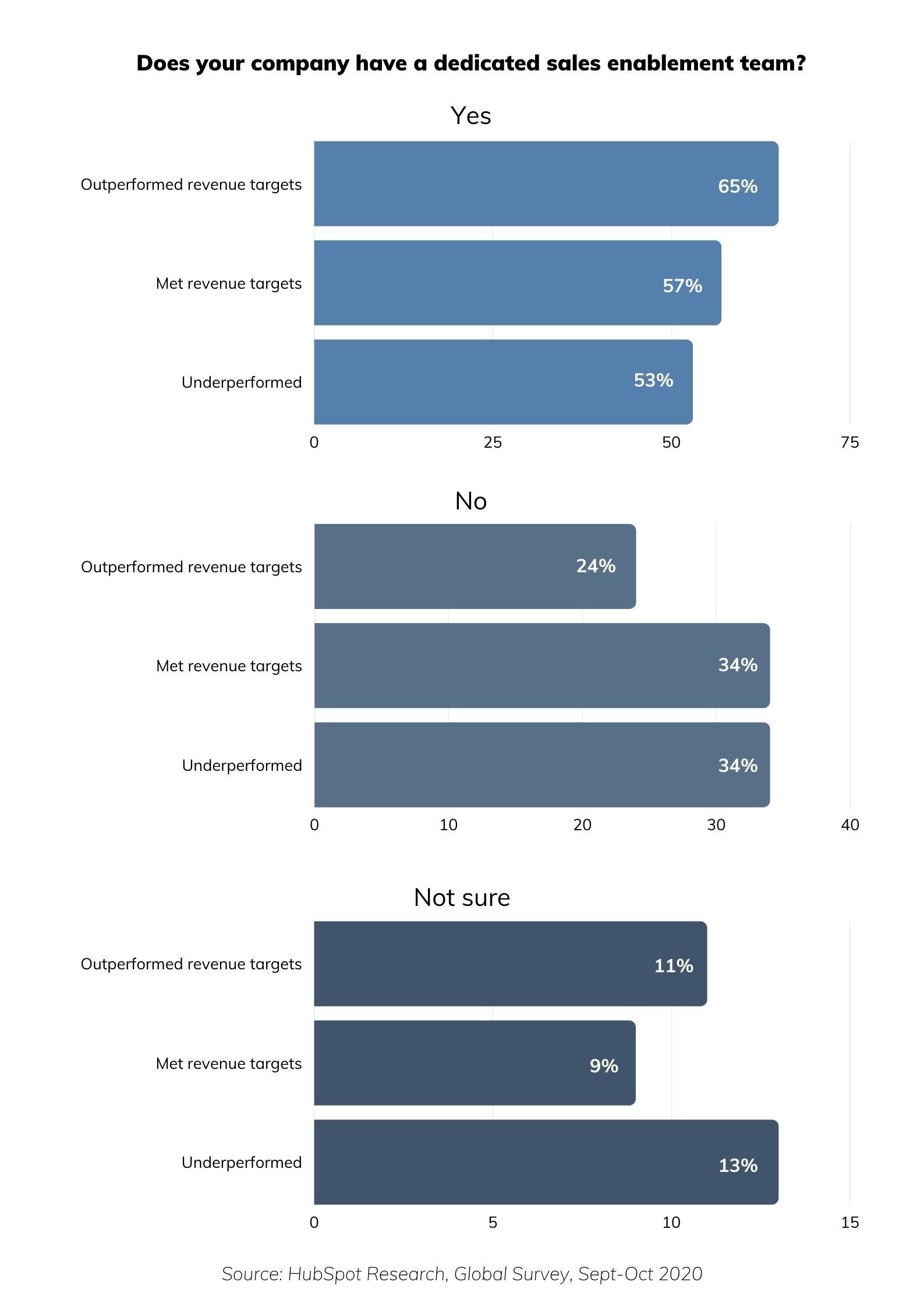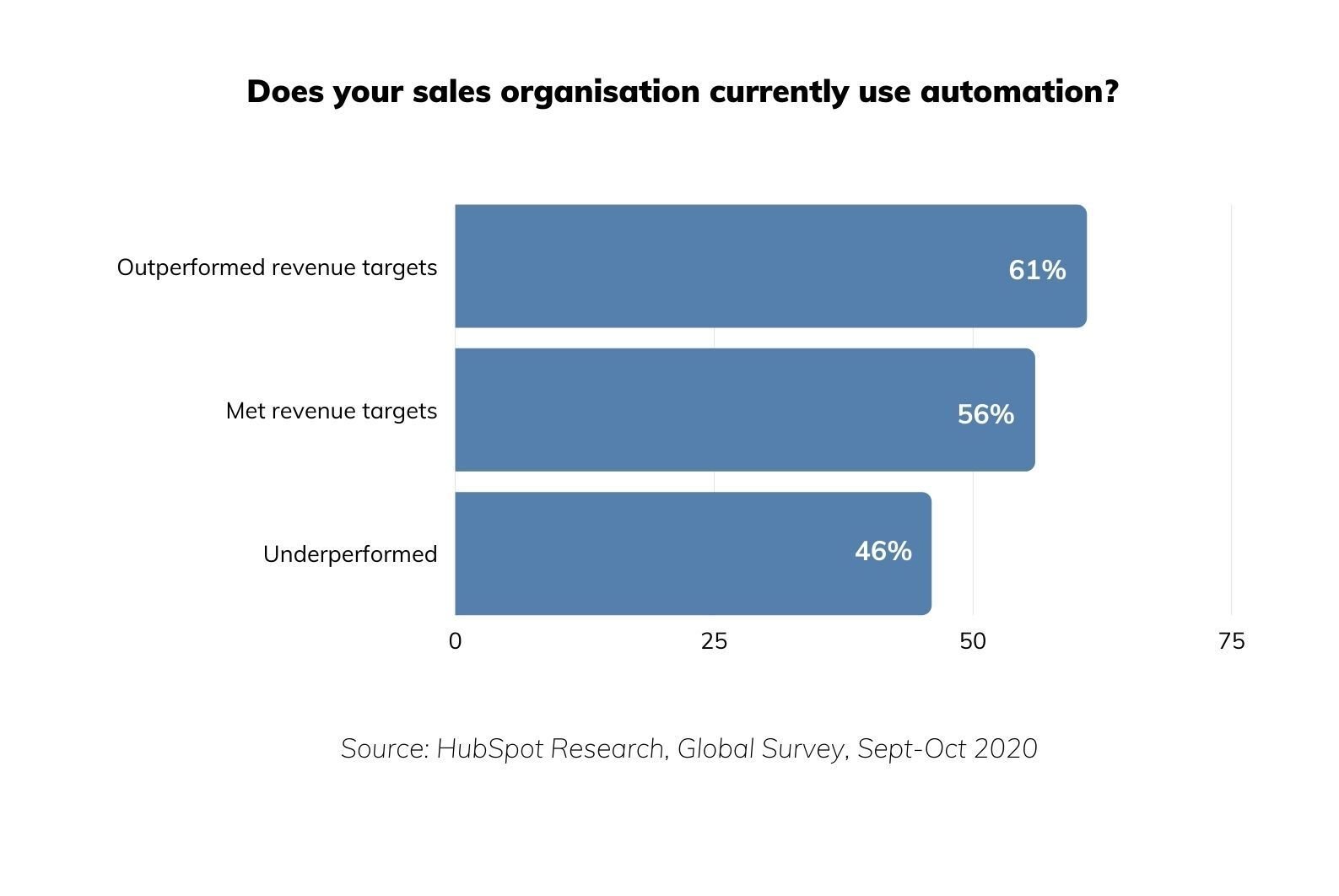What is sales enablement?
Sales enablement has recently surged in popularity, experiencing a 343% increase in adoption over the last 5 years.
And the impact of a sales enablement strategy?
65% of Sales leaders with a dedicated sales enablement team outperform against revenue targets.
Organisations that have a formal sales enablement charter achieve a 12% higher win rate than organisations without one.
These are all clearly compelling numbers.
So the question often asked is: what is sales enablement and how do I deploy it in my organisation?

So what is sales enablement?
Simply put, sales enablement is the process of providing the collateral, content, data, insights, tools and technology that your Sales teams need to work seamlessly, delivering the best prospect and customer engagement experience.
But it also goes beyond all of the above. Sales enablement looks at optimising the entire prospect and customer engagement process to provide the least possible friction in the buyer’s journey.
To put it into sporting terms:
It’s the equivalent of coaching your team - physically, mentally and emotionally. Giving them the very best equipment - often customised to the individual needs of each team member.
It’s the support staff you have to support them - the coaches, the team doctor, the performance coach, the backroom staff, etc. All backed up by a management team that invests for today and tomorrow.
You want your team (in this case your Sales team) to perform the best. So you put in place an infrastructure that will remove all barriers, reduce all friction and ensure they can perform to the best of their abilities.
Ultimately, the winner is the organisation, as the compelling figures above attest.
The B2B buyer has changed
We’ve all seen the research.
The B2B buyer has changed beyond all recognition. 60% of B2B buyers (I’d say more…) want sellers to demonstrate:
• Knowledge of their industry
• The issues facing their industry
• Knowledge of their company
• The challenges facing their company.
What’s the impact on Sales professionals of this shift in B2B buyer behaviour?
Quite simply, Sales professionals can’t just be experts in their company’s products and solutions. They must be experts in their customers and prospects’ companies.
They need to demonstrate insight and be key advisors to help their customers (actual or potential) understand what is happening in their industry, what are the key challenges, threats (and opportunities).
It is rare these days for any product or solution to act in isolation (particularly with technology sales). This inevitably leads to system integrations (and the challenges therein) and customers expect any seller to have a much wider field of vision than previously.
You can now see how sales enablement is a critical element to activate for any Sales team to compete.
Remote working challenging the established norm?
2020 has changed sales (and sales enablement) forever.
No one is in the office. No one is answering their work phone. Everyone is on ZOOM. Everyone is working very differently.
It is the year of ‘remote sales’.
HubSpot’s Global Sales Enablement Survey 2020 has found that 64% of those who transitioned to remote sales either met or exceeded their revenue targets, compared to 50% of those who didn’t make the transition.
In fact, 72% of over-performing Sales leaders say that virtual meetings have been as or more effective than face to face meetings.
Which, some may argue, completely contradicts traditional beliefs about sales. After all, we’ve spent years focusing on building human, face-to-face interactions with customers, only now to find that remote sales works too (and well).
So what’s the relevance here to sales enablement?
Many businesses are turning to automation and technology to help optimise the sales process.
This means more video calls (47.99% ranked “video conferencing software” as the most important tool to their team’s success) and an easily accessible CRM to share data and insights across the business (ranked as the second most important tool for all Sales leaders).
This shift calls for a review of your sales enablement strategy and new training programs for this remote era.
Sales enablement and Account-based Marketing
We spoke only last week about the importance of Sales and Marketing alignment for ABM success.
Depending which research you read, only some 8-17% of Sales and Marketing teams are fully aligned..
While there are many reasons behind this low adoption rate - cultural, leadership, strategy, maturity, etc - one of the underlying reasons is sales enablement - or rather lack thereof.
76% of content marketers forget about sales enablement in their marketing efforts.
And this ultimately wastes time and money, as Sales don’t have the tools they need to sell in a quicker and more efficient way.
Account-based Marketing (ABM) changes all this. Without Sales and Marketing alignment there can be no ABM - well there can - but it will be ineffective.
ABM is the Sales and Marketing unifier, aligning the teams on ICP, Accounts, strategy, sales cadence, content, etc.
ABM calls for hyper-targeted, personalised messaging that is relevant to each stage of the buyer’s journey, making account-level insight all the more important.
“Insights are hugely important - they’re the difference between having a meaningful conversation with an account or having a generic conversation with them. If you have insight into the account’s business, into their challenges, into the opportunities in their market, you will be viewed as a trusted advisor.” - Fes Askari, Director of Sales and Strategic Accounts at Strategic IC
Nobody has better insight into the thoughts of the customer than those on the front line.
Sales enablement focuses on using this insight to inform content generation so that the content Sales are provided with is relevant and personalised to the account.
This means aligning with the value proposition, messaging, and content strategy that Marketing has created, so that the content that Sales are given is consistent and relevant to the buyer.
In fact, only 35% of Sales reps believe that marketers know what kind of content Sales teams need to help them engage, nurture, and win accounts.
ABM and sales enablement change that, by involving the Sales team in each stage of the content strategy.
Let’s look at some key steps to achieving sales enablement.
1. Involve Sales in account selection
Whilst Marketing is busy creating the content and messaging used to engage accounts, Sales are out there on the front line engaging with those same accounts.
So it seems obvious that Sales should be involved in the account selection process, right?
But if that’s the case, why is up to 40% of sales time wasted on unproductive prospecting?
It’s clear that many businesses fail to use the account-level insight that Sales can provide when deciding on their ICP and account selection process.
Sales teams need to understand the process, logic, and reasoning behind account selection so that they can go into conversations with the context needed to build meaningful relationships.
And this doesn’t just benefit Sales.
By including Sales in the account selection process, you’ll be targeting accounts that are a better fit for your business, and your win rate will be much higher (53% for businesses with a sales enablement process in place for more than 2 years).
2. Audit your sales process
Before you can assess how to optimise your sales process, you need to understand how the sales process works and which areas need improvement.
By auditing the sales process, you can really get to grips with what the Sales team does, and how they do it, and from here you can examine where there are issues in Sales team execution.
Whether that’s the steps they’re taking the buyer through, the content they’re using, or the Calls-to-Action that they’re providing - it’s really important to dissect the process and assess where you can increase value to the buyer.
Shockingly, only 35% of Sales teams track the effectiveness of their content - this has to change in order to achieve a more efficient sales process!
Sometimes this may mean adapting the messaging strategy so that it’s more buyer-centric. Or maybe it’s just a case of providing the right content at the right stage of the buyer’s journey.
Whatever the issue may be, taking a step back and looking at it from the buyer’s perspective could really help the sales process to run smoothly and efficiently.
3. Align on content generation
Are you singing from the same hymn sheet?
All too often, Marketing come up with some ‘tremendous’ new messaging or value proposition that for X, Y or Z reason is not adopted by Sales.
This lack of coordination is the death knell to any form of coherent messaging strategy and it is manifested by buyers losing interest.
Over 90% of online buyers use digital to research business purchases so any form of misaligned messaging will stand out.
This means that the messaging your business chooses to broadcast on their website, on their social media, and anywhere else online will be a major deciding factor of whether or not that customer decides to buy.
So it’s essential that the messaging delivered to an account is relevant and consistent.
And it’s also about creating content that is effective.
You may have created an eBook or white paper that demonstrates the reasons why an account should buy your product or service, but it’s useless if the account doesn’t even open it.
In fact, 54% of customers think companies need to fundamentally transform how they engage.
This is where the value of sales comes in.
Your Sales team will be able to provide invaluable insight into the effectiveness of different content at different stages of the buyer’s journey.
Sales also has deep insight into the challenges faced by the customer. You can use this to personalise your content and make it meaningful and relatable to the buyer.
It’s not just about the ‘what’. It’s also about the ‘when’!
Knowing when to deliver content to accounts is crucial to achieve ABM success. It’s all about the context, relevance, and timing.
For example, 60% of B2B buyers want to connect with Sales during the consideration stage, after they’ve researched the options.
So in these situations, approaching the buyer before they reach this stage in the buyer’s journey may do more harm than good.
You may have a great product, and it may be a perfect fit for this specific account, but if the timing is out and they are not yet in a position to buy, the whole effort is meaningless.
On the front line, Sales know what stage the account is at in the buyer’s journey, and how likely they are to buy.
If Marketing uses this insight to inform messaging, the content that account receives will be far more relevant to their situation.
4. Invest in sales enablement technology
74% of businesses that use CRM and marketing automation have aligned Marketing and Sales departments.
Using the right technology and automation platforms not only makes it easier to access data and cross-departmental insight, but it also helps to support various areas of the business.
In fact, 61% of over-performing leaders use their CRM to automate parts of their sales process, vs. 46% of under-performing leaders.

There are a range of CRM and automation platforms available, such as HubSpot which features both ABM features as well as marketing automation.
“You have essentially one source of truth, consolidated in one location.” - Gideon Thomas, VP of Marketing and Growth at DealHub, Let’s Talk ABM
Sales teams can also set up notifications on their CRM to assess account engagement and use this as an indicator of when to reach out with more content.
From reporting, to real-time data management, to automation - optimising your tech stack to allow for sales enablement will ultimately allow for more efficient and streamlined processes across the entirety of your business - not just the Sales team.
What outcomes can you expect to see from sales enablement?
There are really no excuses for not deploying a sales enablement strategy - be it a formal support team or some form of charter and alignment between Sales and Marketing.
The increased popularity of ABM has shone a spotlight on this Sales and Marketing alignment and an accompanying sales enablement strategy. .
Let’s wrap up with some (more) numbers!
Businesses that have adopted sales enablement have reported:
• an average win rate of 49%, which is 12% higher than organisations without a formal sales enablement charter
• a 67% higher probability that marketing-generated leads will close when Marketing and Sales teams are aligned
• an almost 14% increase in their annual contract values and overall deal size
And not to mention the vast array of benefits that come with stronger Marketing and Sales alignment. 
Want to find out more about sales enablement in the context of ABM? Take a look at our Let’s Talk ABM interview series for some valuable insight from leading industry experts shaping the future of ABM.



